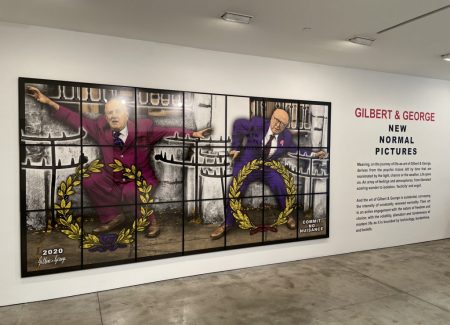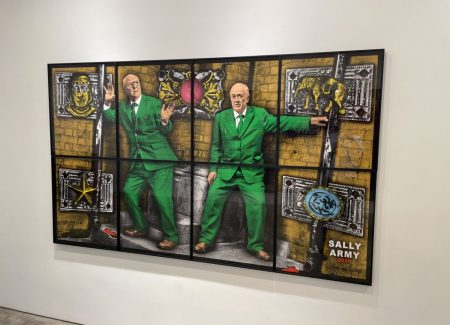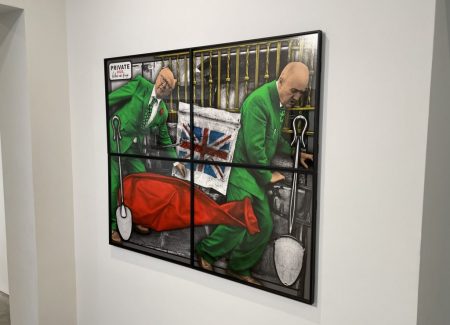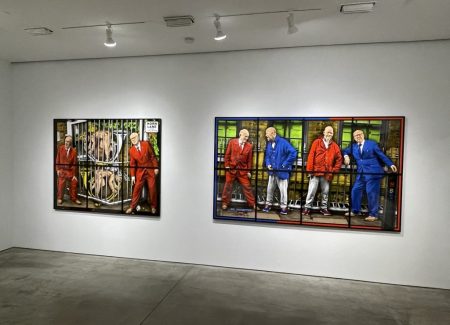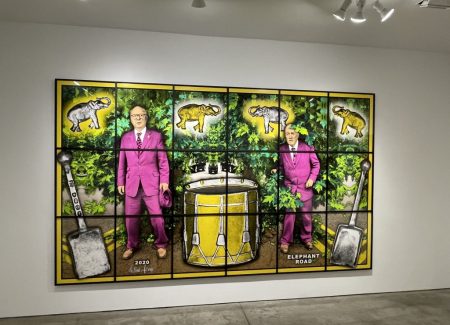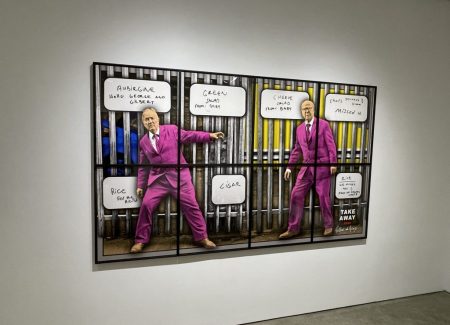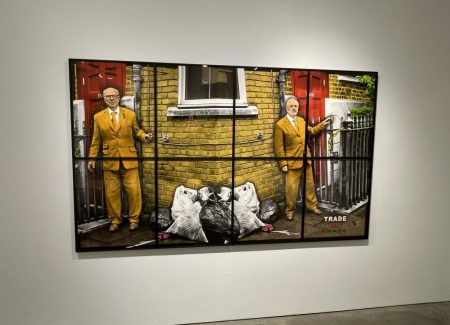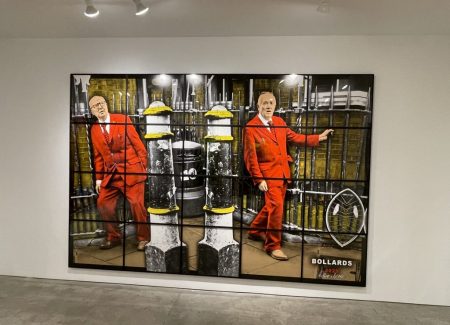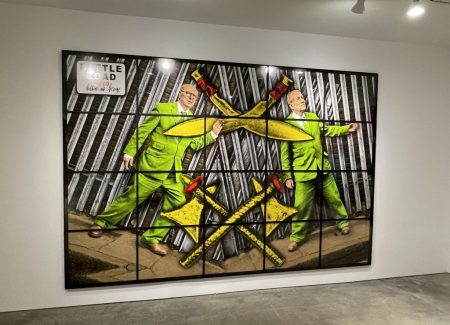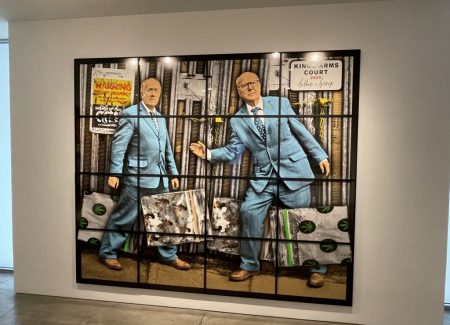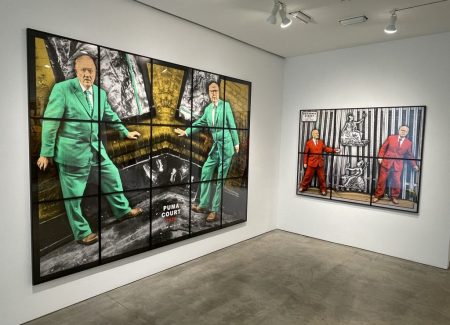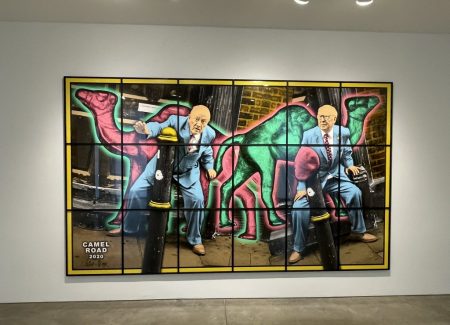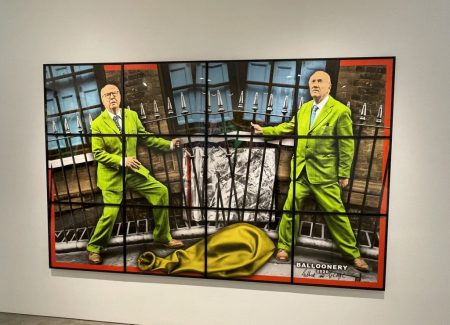JTF (just the facts): A total of 22 multi-panel color works, framed in black and unmatted, and hung against white walls throughout the six rooms of the gallery. All of the works are described as mixed media, made from between 4 and 21 photographic panels. The resulting works range in physical size from roughly 50×60 to 90×175 inches, and all of the works are unique. (Installation shots below.)
Comments/Context: As more time passes between the beginning of the Covid-19 outbreak (in roughly March of 2020) and the present, many more of the projects that artists worked on during their months of lockdown, quarantine, and general isolation are starting to emerge. And while it might be too early to try to discern broad patterns in what will soon be deemed pandemic-era art, it is clear that many artists were forced to cut back, to simplify, or to return to first principles, simply because they couldn’t get to their studios, get help from assistants, or travel far from their homes. The pandemic forced a wholesale re-evaluation of how we live and work, and that process of purposeful rethinking spawned a practical, back-to-basics movement in how many artists have engaged with their craft.
Coming off the overdone excesses of their 2017 Beard Pictures (reviewed here), Gilbert & George were in many ways due for a moment of retrenching and reset anyway, and their New Normal Pictures re-establish a more modest aesthetic baseline. The duo has returned to the streets and local neighborhoods of London (still available as a setting during the lockdowns) and they have brought back the full body, matching suits attire that was their original signature (the Beard Pictures were mostly derived from faces and torsos, and the inventive tabloid wordplay of the 2012 London Pictures (reviewed here) similarly downplayed their physical presence.)
The “new normal” of Gilbert & George’s life during the double whammy of the pandemic and post-Brexit is notably uncertain and off-kilter. As they wander the empty streets and sidewalks, the environment isn’t particularly welcoming or appealing, especially for a pair of elderly men. Brick walls, iron railings, steel fencing, and concrete parking bollards (all seemingly seen on dark grey days) are their consistent background, the patterns of vertical lines and interlocking bricks creating a gritty fenced-in, blocked-off texture that tightly surrounds the two artists.
All of the works on view are constructed from pairs of views of Gilbert & George, with each initially seen separately. When the two (or more) images are combined, the angle of view is never matching, creating distortions that make the ground seem to tilt, bend, and skew. These upendings are made more pronounced by the way the two stand and sit, often leaning on a railing, hanging from a used clothing collection bin, or slumping on a bus stop bench. The result is a set of pictures that make Gilbert & George look subtly disoriented, unsettled, and out of sorts, almost as if they are ready to tumble over in a few cases. Their aging faces reflect this unease, with blank glassy-eyed expressions that imply momentary confusion or hanging on.
With this as a general visual framework, Gilbert & George then highlight details, both those present in the street photographs and those added in later for amplification. The grimy mood continues with bags of trash on the sidewalk, printed drug baggies, deflated balloons, and other garbage-related items, from street-side bins and shovels to the appearance of one garbage collector with his rolling can. This parade of refuse and decay is then balanced by various symbols of empire, including battle axes, flags, garlands, elephants, camels, and royal insignia. The friction between these two sets of imagery is clear, the old and new worlds mixing uncomfortably.
The last tool deployed by the two artists in these pictures is a precise control of color. In general, the backdrop scenes and settings have been desaturated to the point that they are essentially black-and-white, creating the general drab mood. Color is then introduced as isolated tinting, and has been applied to the matching suits of the artists as well as to various key objects in the compositions. The colors are bright and intense, popping against the deliberately muted setups, and are often paired or repeated. The way the color is used further exaggerates the contrasts, adding a dose of exaggeration and caricature.
The best of the images from the New Normal Pictures underscore the prevailing uncertainty of the pandemic mood. When the two artists looked wrongfooted and perplexed by the reality of the streets, and when the grandeur of the old has been overcome by the debris of the present, the pictures touch a nerve that feels surprisingly authentic. With such a large body of work, there is of course unevenness in the execution here, but a handful of these scenes have just enough bite to be memorable. Even in their most deliberately absurd creations, Gilbert & George’s artistic response to the pandemic is unexpectedly measured and personal, each trip out into the streets of London offering a subtle reflection of the deepening societal unease to be found there.
Collector’s POV: The works in this show range in price from £60000 to £140000, based on the number of panels. In general, works by Gilbert & George can be found at auction with regularity at this point, mostly in Contemporary Art sales as opposed to Photographs sales. Prices for their multi-panel works have ranged between roughly $50000 and $1800000 in the past decade, with a few single image or editioned works at lower prices.
